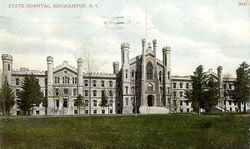Difference between revisions of "Binghamton State Hospital"
m |
M-Explorer (talk | contribs) |
||
| Line 31: | Line 31: | ||
In 1942, the hospital instituted electric shock therapy, hydrotherapy and later lobotomy as methods of treatment for the mentally ill. These “treatments” were nothing short of brutally inhumane. Patients were restrained in wet canvas for up to six hours at a time and forced into seizures by means of electric shock. The worst and most terrifying of these treatments was the prefrontal lobotomy, a form of psychosurgery that involved scrambling the frontal lobe of the brain with a sharp metal instrument inserted through the upper eye socket. | In 1942, the hospital instituted electric shock therapy, hydrotherapy and later lobotomy as methods of treatment for the mentally ill. These “treatments” were nothing short of brutally inhumane. Patients were restrained in wet canvas for up to six hours at a time and forced into seizures by means of electric shock. The worst and most terrifying of these treatments was the prefrontal lobotomy, a form of psychosurgery that involved scrambling the frontal lobe of the brain with a sharp metal instrument inserted through the upper eye socket. | ||
| − | The hospital fell into steep decline in the late 1900s with the introduction of modern medicinal treatments, until it finally closed its doors in 1993 | + | The hospital fell into steep decline in the late 1900s with the introduction of modern medicinal treatments, until it finally closed its doors in 1993. The building was declared a National Historic Landmark in 1997. |
Revision as of 16:33, 27 February 2021
| Binghamton State Hospital | |
|---|---|
 | |
| Opened | 1858 |
| Closed | 1993 |
| Current Status | Preserved |
| Building Style | Cottage Plan |
| Architect(s) | Isaac G. Perry |
| Location | Binghamton, NY |
| Architecture Style | Gothic Revival |
| Alternate Names |
|
History
Built in 1858, the castle originally served as the country's first inebriate asylum. Founder J. Edward Turner belonged to a school of thought that alcoholism wasn't just a vice, but could be cured medically. The well-lit rooms and extensive grounds are an important marker in New York State's view of addiction. The asylum was the first of its kind in the country, but only served its original purpose for 15 years, at which point Turner's inebriate asylum was converted into a hospital for the chronically insane. The asylum faced financial woes for a decade after a great fire broke out in March 1870. Gov. Lucius Robinson deemed it a “complete failure” in 1879, suggesting that the asylum be closed down and renovated to house the insane. In 1881, its doors were reopened as the Binghamton Asylum for the Chronic Insane, later renamed the Binghamton State Hospital. Hundreds of patients were transferred to Binghamton from Utica, Poughkeepsie and Middletown; those patients lived, suffered and died in the palatial asylum. Treatment methods only worsened with the turn of the century.
In 1942, the hospital instituted electric shock therapy, hydrotherapy and later lobotomy as methods of treatment for the mentally ill. These “treatments” were nothing short of brutally inhumane. Patients were restrained in wet canvas for up to six hours at a time and forced into seizures by means of electric shock. The worst and most terrifying of these treatments was the prefrontal lobotomy, a form of psychosurgery that involved scrambling the frontal lobe of the brain with a sharp metal instrument inserted through the upper eye socket.
The hospital fell into steep decline in the late 1900s with the introduction of modern medicinal treatments, until it finally closed its doors in 1993. The building was declared a National Historic Landmark in 1997.
Images of Binghamton State Hospital
Main Image Gallery: Binghamton State Hospital
Books
- Drunkard's Refuge: The Lessons of the New York State Inebriate Asylum, by John W. Crowley and William L. White


